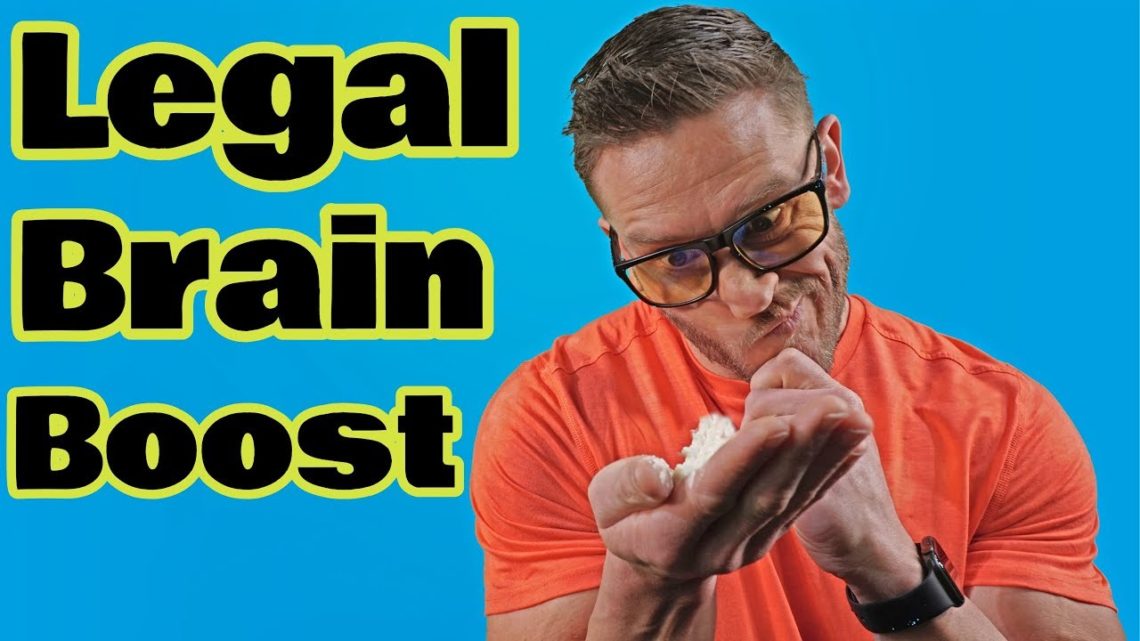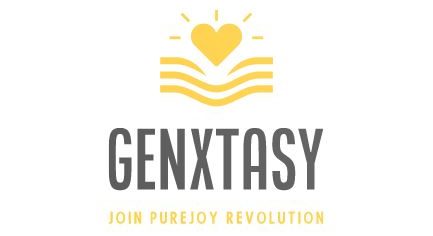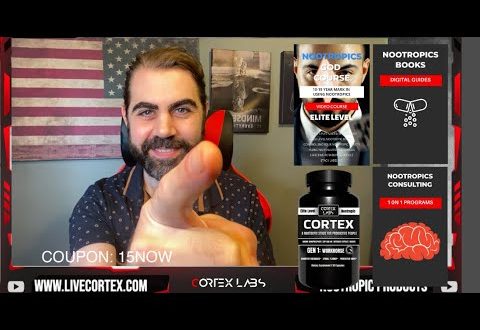
Creatine vs. Brain Function | How to Boost IQ with Creatine (Legal Nootropic)- Thomas DeLauer
Click Here to Subscribe: http://Bit.ly/ThomasVid
My Special Discount on Four Sigmatic’s Lion’s Mane Elixir: http://foursigmatic.com/thomasdelauer
Choose your Creatine over on Amazon (Avoid Creatine Ethyl Ester): https://www.amazon.com/s?k=creatine&ref=nb_sb_noss_2
My Website: http://ThomasDeLauer.com
Creatine vs. Brain Function | How to Boost IQ with Creatine (Legal Nootropic)- Thomas DeLauer…
Creatine is a substance naturally produced in the body from amino acids (formed from the combination of the amino acids arginine and glycine) – most of it is stored in muscle cells and released during physical activity. Creatine supplements are commonly purchased to raise muscle creatine stores, which enhances exercise performance and helps build muscles.
Importance of Creatine:
Our cells run on energy supplied by ATP (think of ATP as the gasoline of the body) – whether we fuel up with glucose or ketones, eventually they get transformed into ATP, which powers energy-requiring processes. We will obviously burn through ATP faster in our muscles when we are running or jumping or performing various feats of strength, but we also burn through ATP faster when we are using our brains for something complicated. Our little brain burns through 20% of the energy we use each day, primarily to keep ion gradients fueled that allow our neurons to charge up and then be discharged to communicate information. Creatine can bind to phosphate (P) to make phosphocreatine, and this acts as a “buffer” to make ATP quick. Turns out we can make ATP 12 times faster using phosphate reserves from phosphocreatine than by using the standard method of oxidative phosphorylation and a whopping 70 times faster than making ATP de novo.
*Creatine isn’t specifically a muscle building supplement, it’s an energy building supplement*
Creatine & ATP:
(ATP) is an adenosine with three phosphate groups attached. When our cells need energy, our mitochondria (our cells batteries) break off a phosphate molecule and when the bond is broken it releases energy that the cell can use to get things done. This converts ATP to ADP (adenosine Diphosphate), which cannot be used for energy production. There is only so much ATP available within a given amount of time, which means that the more energy your body demands, the quicker ATP will run out and your body will fatigue. Creatine is stored in the body as Creatine-Phosphate – so when ATP becomes ADP, creatine comes in to save the day by providing it’s phosphate back to ADP so that it can become “recharged” and become ATP again, which can then be used for energy. Creatine is essentially an energy recycler and booster.
Creatine & The Brain:
The next biggest storehouse of creatine, after your muscles, is your brain cells – your brain uses 20% of your body’s total energy usage every single day and the more you use your brain, the quicker you drain your ATP reserves. Creatine helps revive your brain cells in a similar fashion to your muscles cells, it helps “refill” your ATP supply so that your brain can continue to perform at its best longer. Therefore creatine can be classified as a Nootropic.
Mental Fatigue & Memory:
A study published in the Proceedings of the Royal Society B: Biological Sciences took two groups of vegetarians and vegans. One group was given 5g of creatine/day over a 6-week period, while the second group received placebos. Both groups were given IQ tests at the beginning and completion of the 6-week study. The group supplementing with creatine saw their IQ’s go up an average of 20% over the 6-week period while the group receiving placebos saw no significant change.
https://www.ncbi.nlm.nih.gov/pmc/articles/PMC1691485/pdf/14561278.pdf
Enhancing Nootropic Effect:
Four Sigmatic’s Lion’s Mane & Reishi- Nerve Growth Factor (NGF) is a neurotrophic protein that is guided into production by the BDNF gene. It is also considered a neuropeptide, or a molecule that resembles a protein and is used by neurons for communication.
Neurons in the brain use Nerve Growth Factor to communicate within short distances – neurons also use NGF for maintenance, development and practical functioning in our central and peripheral nervous systems. Essentially, the peripheral nervous system collects sensory messages (in the form of neurons) from the body. Then, it sends these neural messages to the central nervous system for interpretation by the brain. NGF has shown to be present in the hippocampus, which is associated with memory. Both lion’s mane and reishi mushrooms have been shown to activate the production of NGF in the brain.
Resources:
1)https://www.ncbi.nlm.nih.gov/pmc/articles/PMC1691485/pdf/14561278.pdf
2) https://www.psychologytoday.com/us/blog/evolutionary-psychiatry/201202/your-brain-creatine
3) https://medium.com/swlh/the-surprising-fitness-supplement-that-can-help-you-bulk-up-your-brain-power-64c94a5c4b29
4)https://www.sciencedirect.com/science/article/pii/S092544390500133X
source






45 Comments
Finmatic
I just want to know if creatine is bad I have kidney stones
Todd google
Thomas is an excellent content creator. Huge props after being on MPD show.
ZEUS O.
In other words, being vegan makes you 20% dumber.
jedlimen123
Better git me some!! Thank you!! ?
BinoWorld UK
Great Video! Can a well contrôles Diabetic 2 person consume 1 to 3 grams a day of creatine ??
J DuB
I work a 12 hour shift yesterday and brain wasn’t even drained at all! And I’m only in a load phase!
Alto 33
Do you know if I can mix Caffeine,L-Theanine,MCT Oil, Lions mane and Creatine at the same time?
luv2travel2000
@ 1:45 Study showed taking 5 GM of creatine daily for a few weeks improved IQ test by 20%. Wow! Even 1 – 2 GM daily will give you a phenomenal brain boost. Creatine Monohydrate. (Cheap is fine.) Best if you take it with Lion's Main or reishi mushrooms.
luv2travel2000
Start with 1 GM creatine. Work up to 5 grams.If you start to retain fluid, reduce by one gram and there's your sweet spot.
Thanks Thomas for this video!!!
Jonah D
creatine seems op
Baba_Smallz
Had creatine for a month and understood everything in these videos without rewinding
Peter Symons
Thank u
K
anybody else here totally looses verbal fluency and IQ on the second or third day of taking creatine monophosphate every single time no matter the dosage?
Escargot
wouldn’t gym rats be the smartest people in the world then? i’m skeptical if this claim. generally love the content though
Alvin WE
The fact that he said this in one take proves creatine improves creatine benefits brain function. I couldn't do that if someone pointed a gun at me
Charlie Chimp
But for a malnourished brain it's obvious it will boost performance
Gil Clifton
I don't understand very well : did creatine replace lion's mane effect?
Free Loop
thank you a lot. that's really helpful.
Bylup Bylup
Informative video.. I was taking creatine for 2 and a half years and it was the best. But I was using it with a pre workout. One day I accidentally took 2 doses of this within a span of 2 hours and I believe I overdosed on it. I had anxiety for a week. Stopped all my supplements even coffee and any caffeine. Went to my dr and she told me I had High blood pressure. I was having heart palpitations for months after and my stamina is shot even when I’m at work. Could that be an effect on stopping? Or just taking to much? To this day I have the symptoms.
Thank you for the video!
John Green
does creatine's brain boost work only for vegetarians ?
Timbo Ranker
But creatiein is best bro ?
Timbo Ranker
?
Timbo Ranker
?
Diane Rose
And the long term affects for peoples’ kidneys? That’s a big deal
Diane Rose
Also I have a severe allergy to mushrooms, so can I substitute with other nootropic? No kidney problems
Alignment
I am a vegan is there a vegetable alternative for creatine?
Daniel Roman
Wow. Thanks For The Info: Just Subscribed. Notification GanG ??
Jessla Gooch
It's real it works I took it over 20 years ago for about 1 year. I experienced a huge endurance gain more than I could believe actually .I stoped using it because of roomers from Hercules actor .
Roger San
AWESOME
Auron Silverburgh VGM
How many grams rei-shi mishroom powder do you recommend per day?
GAILANN26
Hello Thomas , thank you again, but can you take creatine with Alpha GPC 300???
Self Care
Would it help people with TBI?
Link Link
ADHD folks love nootropics.
Link Link
Creatine made me so drowsy
Blaze Hall
Man this guy has covered everything related to supplementation and nutrition
swastikexe
now just see how i top my exams AND become swole at the same time!
Stephanie S
can i take creatine with beet root powder and spirulina? I took reishi for a month and it just made me exhausted
Sam Samaraweera
Watching this whilst drinking my creatine ?
Victor Finngall
I guess that's why gym golems have a stereotype for not being that smart. Their muscles are using the majority of their creatine.
Phillip Lanos
Dude, just minutes in and your video hit hard. I could Immediately tell you know your stuff.
Thanks for your work man.
Kabir Saheb
Does after leaving creatine brain booster effect goes away…. Plz do reply…!!
TheCloud
Any study or a paper that is based on "Observation" is a misleading study and most probably is to be used to direct the public to use some products for advertising and commercial purposes and sometimes for political reasons.
Human Intelligence Research
BULLSHIT
Brandon Shreve
So creatine is like the plug wire going to a spark plug in an internal combustion engine? Proper analogy, or is creatine the actual spark plug?
bigdi77
This man is smart his videos help me turn my life around with my diabetes. And now this